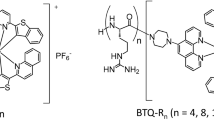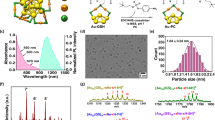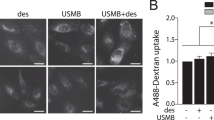Abstract
Technologies are needed to map and image biological barriers in vivo that limit solid tumor delivery and, ultimately, the effectiveness of imaging and therapeutic agents. Here we integrate proteomic and imaging analyses of caveolae at the blood-tumor interface to discover an active transendothelial portal to infiltrate tumors. A post-translationally modified form of annexin A1 (AnnA1) is selectively concentrated in human and rodent tumor caveolae. To follow trafficking, we generated a specific AnnA1 antibody that targets caveolae in the tumor endothelium. Intravital microscopy of caveolae-immunotargeted fluorophores even at low intravenous doses showed rapid and robust pumping across the endothelium to enter mammary, prostate and lung tumors. Within 1 h, the fluorescence signal concentrated throughout tumors to exceed the peak levels in blood. This transvascular pumping required the expression of caveolin 1 and annexin A1. Tumor uptake with other antibodies were >100-fold less. This proteomic imaging strategy reveals a unique target, antibody and caveolae pumping system for solid tumor penetration.
This is a preview of subscription content, access via your institution
Access options
Subscribe to this journal
Receive 12 print issues and online access
$209.00 per year
only $17.42 per issue
Buy this article
- Purchase on Springer Link
- Instant access to full article PDF
Prices may be subject to local taxes which are calculated during checkout





Similar content being viewed by others
References
Dvorak, H.F., Nagy, J.A. & Dvorak, A.M. Structure of solid tumors and their vasculature: implications for therapy with monoclonal antibodies. Cancer Cells 3, 77–85 (1991).
Greish, K. Enhanced permeability and retention of macromolecular drugs in solid tumors: a royal gate for targeted anticancer nanomedicines. J. Drug Target. 15, 457–464 (2007).
Hait, W.N. & Hambley, T.W. Targeted cancer therapeutics. Cancer Res. 69, 1263–1267, discussion 1267 (2009).
Jain, R.K. The next frontier of molecular medicine: delivery of therapeutics. Nat. Med. 4, 655–657 (1998).
Weissleder, R. & Pittet, M.J. Imaging in the era of molecular oncology. Nature 452, 580–589 (2008).
Willmann, J.K., van Bruggen, N., Dinkelborg, L.M. & Gambhir, S.S. Molecular imaging in drug development. Nat. Rev. Drug Discov. 7, 591–607 (2008).
Nie, S., Xing, Y., Kim, G.J. & Simons, J.W. Nanotechnology applications in cancer. Annu. Rev. Biomed. Eng. 9, 257–288 (2007).
Schnitzer, J.E. Vascular targeting as a strategy for cancer therapy. N. Engl. J. Med. 339, 472–474 (1998).
Sugahara, K.N. et al. Coadministration of a tumor-penetrating peptide enhances the efficacy of cancer drugs. Science 328, 1031–1035 (2010).
Hajitou, A., Pasqualini, R. & Arap, W. Vascular targeting: recent advances and therapeutic perspectives. Trends Cardiovasc. Med. 16, 80–88 (2006).
Carver, L.A. & Schnitzer, J.E. in Endothelial Biomedicine (ed. Aird, W.C.) 664–678, 881–898 (Cambridge University Press, 2007).
Durr, E. et al. Direct proteomic mapping of the lung microvascular endothelial cell surface in vivo and in cell culture. Nat. Biotechnol. 22, 985–992 (2004).
Huang, X. et al. Tumor infarction in mice by antibody-directed targeting of tissue factor to tumor vasculature. Science 275, 547–550 (1997).
Li, Y. et al. Enhancing identifications of lipid-embedded proteins by mass spectrometry for improved mapping of endothelial plasma membranes in vivo. Mol. Cell. Proteomics 8, 1219–1235 (2009).
Oh, P. et al. Live dynamic imaging of caveolae pumping targeted antibody rapidly and specifically across endothelium in the lung. Nat. Biotechnol. 25, 327–337 (2007).
Oh, P. et al. Subtractive proteomic mapping of the endothelial surface in lung and solid tumours for tissue-specific therapy. Nature 429, 629–635 (2004).
Oh, P., McIntosh, D.P. & Schnitzer, J.E. Dynamin at the neck of caveolae mediates their budding to form transport vesicles by GTP-driven fission from the plasma membrane of endothelium. J. Cell Biol. 141, 101–114 (1998).
Schnitzer, J.E., Liu, J. & Oh, P. Endothelial caveolae have the molecular transport machinery for vesicle budding, docking, and fusion including VAMP, NSF, SNAP, annexins, and GTPases. J. Biol. Chem. 270, 14399–14404 (1995).
Schnitzer, J.E., McIntosh, D.P., Dvorak, A.M., Liu, J. & Oh, P. Separation of caveolae from associated microdomains of GPI-anchored proteins. Science 269, 1435–1439 (1995).
Schnitzer, J.E., Oh, P. & McIntosh, D.P. Role of GTP hydrolysis in fission of caveolae directly from plasma membranes. Science 274, 239–242 (1996).
McIntosh, D.P., Tan, X.-Y., Oh, P. & Schnitzer, J.E. Targeting endothelium and its dynamic caveolae for tissue-specific transcytosis in vivo: a pathway to overcome cell barriers to drug and gene delivery. Proc. Natl. Acad. Sci. USA 99, 1996–2001 (2002).
Valadon, P. et al. Designed auto-assembly of nanostreptabodies for rapid tissue-specific targeting in vivo. J. Biol. Chem. 285, 713–722 (2010).
Dvorak, H.F., Nagy, J.A., Dvorak, J.T. & Dvorak, A.M. Identification and characterization of the blood vessels of solid tumors that are leaky to circulating macromolecules. Am. J. Pathol. 133, 95–109 (1988).
Abell, R.G. The permeability of blood capillary sprouts and newly formed blood capillaries as compared to that of older blood capillaries. Am. J. Physiol. 147, 237–241 (1946).
Hobson, B. & Denekamp, J. Endothelial proliferation in tumours and normal tissues: continuous labelling studies. Br. J. Cancer 49, 405–413 (1984).
Lindsay, M.A. Target discovery. Nat. Rev. Drug Discov. 2, 831–838 (2003).
Dalton, W.S. & Friend, S.H. Cancer biomarkers—an invitation to the table. Science 312, 1165–1168 (2006).
Hanash, S. & Taguchi, A. The grand challenge to decipher the cancer proteome. Nat. Rev. Cancer 10, 652–660 (2010).
Huber, L.A. Is proteomics heading in the wrong direction? Nat. Rev. Mol. Cell Biol. 4, 74–80 (2003).
Stratton, M.R., Campbell, P.J. & Futreal, P.A. The cancer genome. Nature 458, 719–724 (2009).
Oh, P., Carver, L.A. & Schnitzer, J.E. in Cell Biology: A Laboratory Handbook 3rd edn. (ed. Celis, J.E.) 11–26 (Elsevier, Amsterdam, 2006).
Borgstrom, P. et al. Co-implanting orthotopic tissue creates stroma microenvironment enhancing growth and angiogenesis of multiple tumors. F1000Res. 2, 129 (2013).
Drab, M. et al. Loss of caveolae, vascular dysfunction, and pulmonary defects in caveolin-1 gene–disrupted mice. Science 293, 2449–2452 (2001).
Hannon, R. et al. Aberrant inflammation and resistance to glucocorticoids in annexin 1−/− mouse. FASEB J. 17, 253–255 (2003).
Yi, M. & Schnitzer, J.E. Impaired tumor growth, metastasis, angiogenesis and wound healing in annexin A1–null mice. Proc. Natl. Acad. Sci. USA 106, 17886–17891 (2009).
Haigler, H.T., Schlaepfer, D.D. & Burgess, W.H. Characterization of lipocortin I and an immunologically unrelated 33-kDa protein as epidermal growth factor receptor/kinase substrates and phospholipase A2 inhibitors. J. Biol. Chem. 262, 6921–6930 (1987).
Wang, W. & Creutz, C.E. Role of the amino-terminal domain in regulating interactions of annexin I with membranes: effects of amino-terminal truncation and mutagenesis of the phosphorylation sites. Biochemistry 33, 275–282 (1994).
Aird, W.C. et al. Vascular bed-specific expression of an endothelial cell gene is programmed by the tissue microenvironment. J. Cell Biol. 138, 1117–1124 (1997).
Schnitzer, J.E., Carley, W.W. & Palade, G.E. Specific albumin binding to microvascular endothelium in culture. Am. J. Physiol. 254, H425–H437 (1988).
Testa, J.E. et al. Immunotargeting and cloning of two CD34 variants exhibiting restricted expression in adult rat endothelia in vivo. Am. J. Physiol. Lung Cell. Mol. Physiol. 297, L251–L262 (2009).
Testa, J.E., Chrastina, A., Li, Y., Oh, P. & Schnitzer, J.E. Ubiquitous yet distinct expression of podocalyxin on vascular surfaces in normal and tumor tissues in the rat. J. Vasc. Res. 46, 311–324 (2009).
Oh, P. & Schnitzer, J.E. Immunoisolation of caveolae with high affinity antibody binding to the oligomeric caveolin cage. Toward understanding the basis of purification. J. Biol. Chem. 274, 23144–23154 (1999).
Harlow, E. & Lane, D. in Antibodies: A Laboratory Manual (Cold Spring Harbor Press, Cold Spring Harbor, New York, 1998).
Acknowledgements
We thank R.D. Winger for performing small animal surgeries and R. Baldwin for assistance with gold labeling experiments. We also thank R.J. Flower (Queen Mary University of London), M. Huflejt (New York University), J. Lustgarten (Mayo Clinic), D. Sanger (Beth Israel Deaconess Medical Center) and R. Tsien (University of California San Diego) for their kind gifts. This research was supported in part by the Komen Foundation, the US Department of Defense (Prostate Cancer Research Program Award number W81XWH-11-1-0693), the state of California (Tobacco-Related Disease Research Program grant 18XT0196 and California Breast Cancer Research Program grant 16IB-0104) and the US National Institutes of Health (R01CA115215, P01CA104898, R01CA119378 and R01CA83989).
Author information
Authors and Affiliations
Contributions
P.O. performed tissue subcellular fractionations, tumor implantations, antibody conjugations, crosslinking studies and western blot analyses. J.E.T. cloned and expressed full-length annexin A1 proteins, performed western blot and immunohistochemical analyses and generated, characterized and supplied mAnnA1. H.W. performed EM analysis with P.O. P.O. and P.B. performed IVM imaging and quantitative analyses. Y.L. performed mass spectrometry analysis. P.O. and J.E.S. designed the experiments and wrote the manuscript.
Corresponding author
Ethics declarations
Competing interests
The authors declare no competing financial interests.
Supplementary information
Supplementary Text and Figures
Supplementary Figures 1 and 2 and Supplementary Note (PDF 919 kb)
41591_2014_BFnm3623_MOESM14_ESM.mov
Continuous imaging of rapid solid tumor penetration with fluorophore linked to mAnnA1 when injected intravenously (MOV 72507 kb)
Rights and permissions
About this article
Cite this article
Oh, P., Testa, J., Borgstrom, P. et al. In vivo proteomic imaging analysis of caveolae reveals pumping system to penetrate solid tumors. Nat Med 20, 1062–1068 (2014). https://doi.org/10.1038/nm.3623
Received:
Accepted:
Published:
Issue Date:
DOI: https://doi.org/10.1038/nm.3623
This article is cited by
-
Targeted drug delivery strategies for precision medicines
Nature Reviews Materials (2021)
-
The entry of nanoparticles into solid tumours
Nature Materials (2020)
-
Overcoming the blood–brain barrier by Annexin A1-binding peptide to target brain tumours
British Journal of Cancer (2020)
-
Targeted drug delivery via caveolae-associated protein PV1 improves lung fibrosis
Communications Biology (2019)
-
Delivered to your door
Nature Reviews Cancer (2014)



